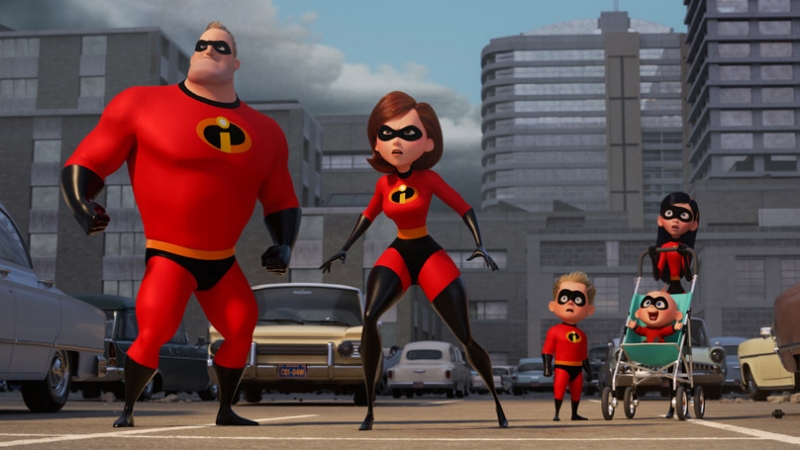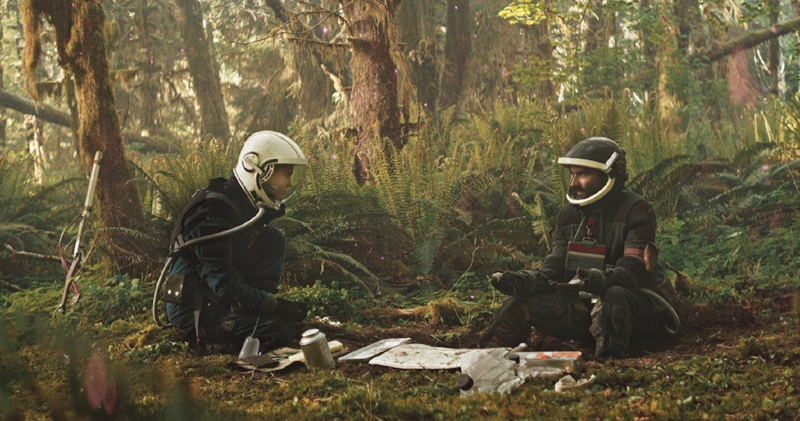INCREDIBLES 2
Directing: B+
Acting: B+
Writing: B+
Cinematography: A-
Editing: B+
Animation: A-
It's been a long time since we last saw The Incredibles -- fourteen years, a record gap for Pixar films, breaking the 13-year record between Finding Nemo and Finding Dory. When The Incredibles was released in 2004, in fact, that was the year I first starting these reviews -- but I missed that film by one month, with my first reviews posted in December 2004, after The Incredibles was released in November.
Although the voice actors have all aged the same fourteen years, their voices for the most part sound the same: once again we get Holly Hunter as Elastigirl; Craig T. Nelson as Mr. Incredible; Sarah Vowell as their daughter; Samuel L. Jackson as their super-best friend Frozone. The one notable change is the voice of young Dash, now Huck Milner because Spencer Fox from the original is too old to play a young boy anymore. I just watched both films in one day though, and their voices sound remarkably similar.
Notable additions this time around include Bob Odenkirk and Catherine Keener as siblings Winston and Evelyn Deavor, who together run a tech company they want to use for advocating renewed acceptance for superheroes. If you think there may be some suspicious motives in there, you'd be right; that's all I'll say about that. Well, except that Catherine Keener is a great choice for any kind of animation voice work, and Winston's likeness is remarkably suggestive of Bob Odenkirk's.
Anyway, fourteen years have passed for us, but for the Incredible family, the story picks up at literally the moment The Incredibles ended. This narrative choice is somewhat of a mixed bag, honestly, and the first fifteen minutes or so of Incredibles 2 sag a bit under the weight of tedious exposition.
But, then things pick up, and the wit and cleverly complex plotting that made the first film so great return. The scene stealer is, once again, superhero suit designer Edna Mode (voiced this time, same as last time, amazingly, by director Brad Bird). The star of this movie, surprisingly, is baby Jack Jack -- who never even has any lines beyond the incoherent babbling of an infant. This underscores the talent on hand over at Pixar Animation Studios, because it's how Jack Jack is animated that makes him so delightful and adorable, from the way he shows off his many superpowers to the way he first puts on his little black superhero mask. These two characters, Edna Mode and Jack Jack, are alone worth the price of admission.
And, although The Incredibles still has the edge for its originality, Incredibles 2 has a much better villain. Syndrome, from the first film, was an annoying pipsqueak you just wanted to slap. Now we get "The Screenslaver," who is at first mysterious and then given a reveal of identity that gives this story a commendable complexity. This villain hypnotizes people via ubiquitous screens everyone is looking at, from TVs to mobile devices, offering a sly commentary on contemporary tech culture. (There's also more than a little irony in showing the trailer for Wreck-It Ralph 2 before this movie, as it apparently moves into the Internet and is clearly packed with endless product placement of the very brands we all look at every day.)
It's also great fun, of course, to see Mr. Incredible and Elastigirl switch roles for a while: Helen is asked to be the face of a campaign to make "supers" favorable to the public again, and in the meantime Bob becomes a stay-at-home dad. It's Mr. Mom for the Pixar Age, and it plays well, illustrating the constraints of gendered expectations without ever getting preachy about it. It's always just fun or funny, especially when Bob struggles to deal with Jack Jack's newly discovered powers. (You may recall they manifested themselves at the very end of The Incredibles, but neither Bob nor Helen were witness to them, so at the beginning of this movie, the family still thinks he's just a normal baby.)
The CG animation is top-notch, as is typically expected of Pixar Films; I particularly enjoyed the many sequences in which the heroes are weaving through and around dense cityscapes. This being Pixar's 20th animated feature, we've long since past the point of being in awe of their technical achievements, but they still remain impressive. Overall, The Incredibles 2 can't exceed the quality of its predecessor, but it comes close enough that nothing about it disappoints. It's every bit the great time you want it to be.
The family that works together stays together: The Incredibles continue living up to their name.
Overall: B+










